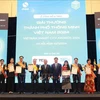Vietnam will build a National Space Centre to maximize the application of space technology in service of the nation’s socio-economic development.
With Japan ’s assistance in design, construction of the 400 million USD facility will start within this year at Hanoi ’s Hoa Lac Hi-tech Zone, according to the Vietnam Science and Technology Academy , which oversees the project.
By its completion in 2018, the centre will entail a satellite assembly, integration and test facility, a satellite signal transmission station, a research center, a space museum and an observatory, said the project manager, Dr. Pham Anh Tuan.
In the future, the Centre plans to undertake technological transfer in order to self-manufacture earth-observing satellites, which are able to watch over the country’s sovereign territory in any weather condition, said the project manager.
The National Space Centre is the cornerstone of the “Strategy on Research and Application of Space Technology to 2020” approved by the Government in 2006.
The strategy aims to lay out a national policy and a legal framework for research and application of space technology along side policies to ensure the provision of human resources and investment for the work.
It also sets the target to develop initial infrastructural facilities for space technology, including a station to receive and process satellite images, and a network of satellite-based positioning stations.
Additionally, the strategy looks forward accepting the transfer of technologies relating to small-sized satellites and building corresponding ground control stations.
Vietnam has begun applying space technology since the 70s and 80s particularly in hydro meteorology, communications, and remote sensing and gained productive results.
However, in the absence of a national policy on space technology research and application, infrastructure and human resources in the field remain insufficient and research and application activities have been done in a dispersed manner, lacking inter-branch coordination.
To boost space technology research and application, experts suggested that the State establish an agency in charge of all related activities, including training a contingent of qualified staff, building technical infrastructure, and provide mechanisms and incentives to invite local and foreign experts to partake in projects in the field./.
With Japan ’s assistance in design, construction of the 400 million USD facility will start within this year at Hanoi ’s Hoa Lac Hi-tech Zone, according to the Vietnam Science and Technology Academy , which oversees the project.
By its completion in 2018, the centre will entail a satellite assembly, integration and test facility, a satellite signal transmission station, a research center, a space museum and an observatory, said the project manager, Dr. Pham Anh Tuan.
In the future, the Centre plans to undertake technological transfer in order to self-manufacture earth-observing satellites, which are able to watch over the country’s sovereign territory in any weather condition, said the project manager.
The National Space Centre is the cornerstone of the “Strategy on Research and Application of Space Technology to 2020” approved by the Government in 2006.
The strategy aims to lay out a national policy and a legal framework for research and application of space technology along side policies to ensure the provision of human resources and investment for the work.
It also sets the target to develop initial infrastructural facilities for space technology, including a station to receive and process satellite images, and a network of satellite-based positioning stations.
Additionally, the strategy looks forward accepting the transfer of technologies relating to small-sized satellites and building corresponding ground control stations.
Vietnam has begun applying space technology since the 70s and 80s particularly in hydro meteorology, communications, and remote sensing and gained productive results.
However, in the absence of a national policy on space technology research and application, infrastructure and human resources in the field remain insufficient and research and application activities have been done in a dispersed manner, lacking inter-branch coordination.
To boost space technology research and application, experts suggested that the State establish an agency in charge of all related activities, including training a contingent of qualified staff, building technical infrastructure, and provide mechanisms and incentives to invite local and foreign experts to partake in projects in the field./.



















